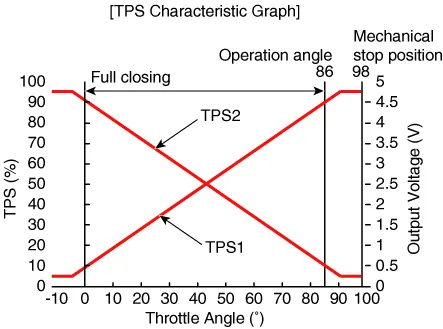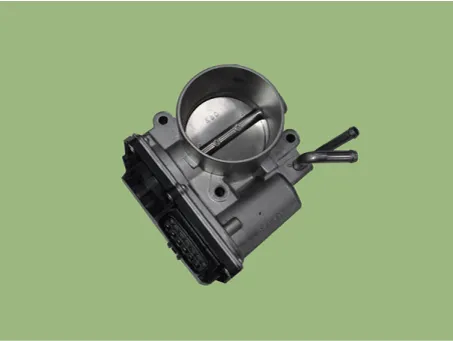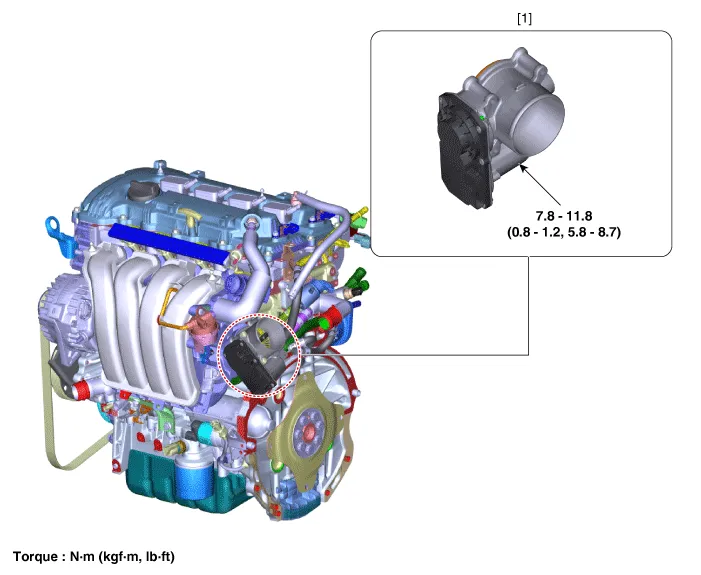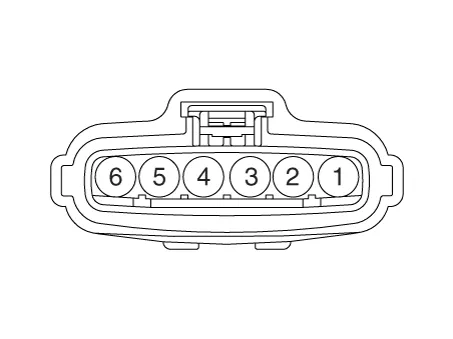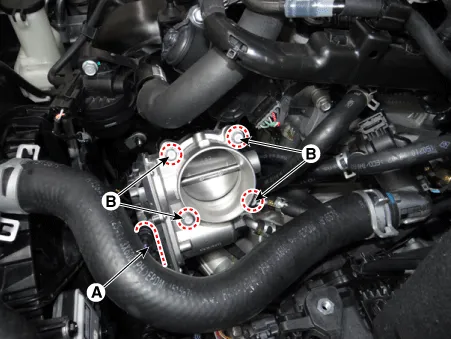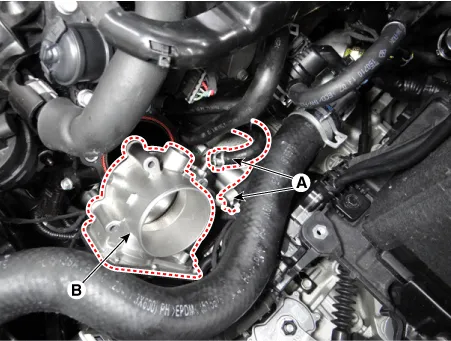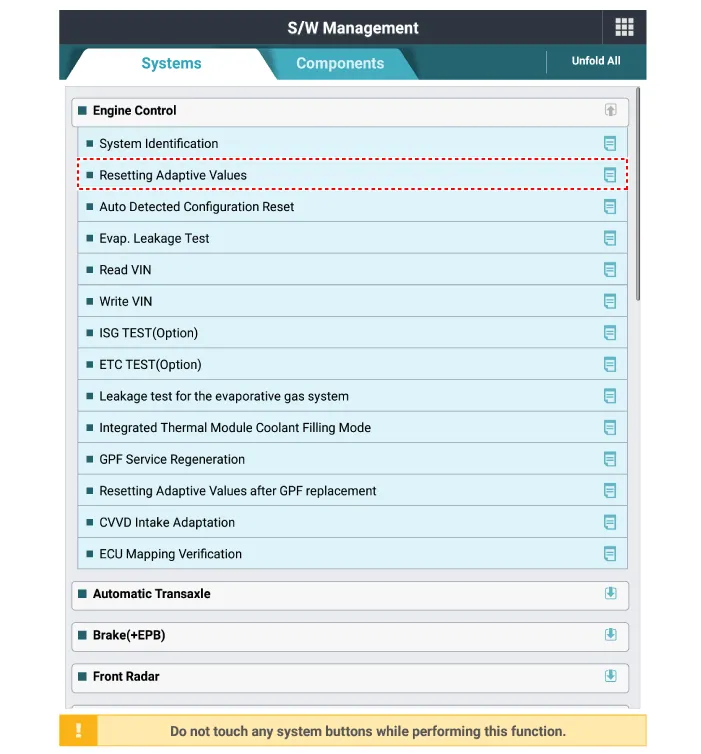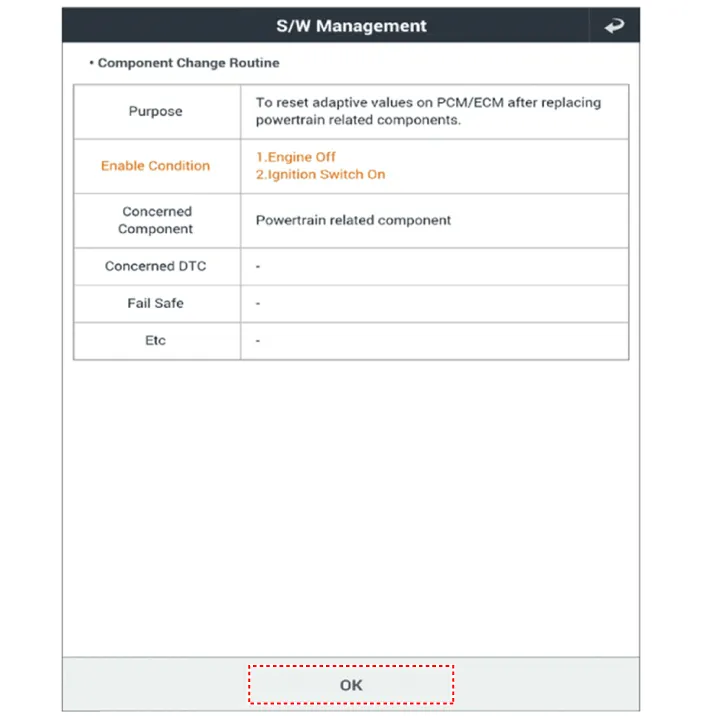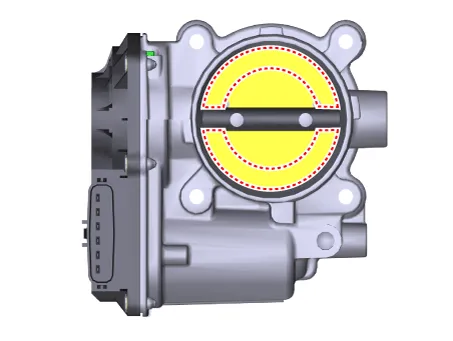Components and components location
Component Location
1. Engine Control Module (ECM)
Schematic diagrams
Connector and Terminal function
ECM Terminal Function
[Connector A]
Pin
Function
Connected to
1
-
2
ETC Motor [+] control output
ETC Motor
3
-
4
-
5
-
6
-
7
-
8
-
9
-
10
-
11
-
12
-
13
-
14
-
15
Sensor ground
Engine Coolant Temperature Sensor (ECTS)
16
Engine Coolant Temperature Sensor (ECTS) signal input
Engine Coolant Temperature Sensor (ECTS)
17
Throttle Position Sensor (TPS) 2 signal input
Throttle Position Sensor (TPS) 2 [ETC Module]
18
-
19
-
20
-
21
Sensor power (+5V)
Manifold Absolute Pressure Sensor (MAPS)
Camshaft Position Sensor (CMPS) [Bank 1 / Intake]
22
-
23
ETC Motor [-] control output
ETC Motor [ETC Module]
24
-
25
-
26
-
27
-
28
-
29
-
30
-
31
Electrical load signal input (FR)
Alternator
32
-
33
-
34
-
35
-
36
-
37
Sensor ground
Throttle Position Sensor (TPS) 1, 2 [ETC Module]
38
Throttle Position Sensor (TPS) 1 signal input
Throttle Position Sensor (TPS) 1 [ETC Module]
39
-
40
Alternator PWM control output
Alternator
41
-
42
Sensor power (+5V)
Throttle Position Sensor (TPS) 1, 2 [ETC Module]
43
-
44
-
45
-
46
-
47
-
48
-
49
-
50
-
51
-
52
-
53
-
54
-
55
-
56
Sensor ground
Camshaft Position Sensor (CMPS) [Bank 1/Exhaust]
57
-
58
-
59
-
60
-
61
Sensor ground
Manifold Absolute Pressure Sensor (MAPS)
62
Manifold Absolute Pressure Sensor (MAPS) signal input
Manifold Absolute Pressure Sensor (MAPS)
63
Sensor power (+5V)
Camshaft Position Sensor (CMPS) [Bank 1 / Exhaust]
65
-
66
-
67
-
68
-
69
-
70
-
71
-
72
-
73
-
74
Sensor ground
Crankshaft Position Sensor (CKPS)
75
-
76
-
77
Camshaft Position Sensor (CMPS) [Bank 1 / Exhaust] signal input
Camshaft Position Sensor (CMPS) [Bank 1 / Exhaust]
78
Sensor ground
Camshaft Position Sensor (CMPS) [Bank 1 / Intake]
79
-
80
-
81
-
82
-
83
VG (Virtual Ground)
Heated Oxygen Sensor [Bank 1 / Sensor 1]
84
VRC (Current Adjust)
Heated Oxygen Sensor [Bank 1 / Sensor 1]
85
-
86
-
87
-
88
-
89
-
90
-
91
-
92
-
93
-
94
-
95
Crankshaft Position Sensor (CKPS) signal input
Crankshaft Position Sensor (CKPS)
96
-
97
-
98
Camshaft Position Sensor (CMPS) [Bank 1 / Intake] signal input
Camshaft Position Sensor (CMPS) [Bank 1 / Intake]
99
Sensor ground
Knock Sensor (KS)
100
Knock Sensor (KS) signal input
Knock Sensor (KS)
101
Intake Air Temperature Sensor (IATS) signal input
Intake Air Temperature Sensor (IATS)
102
-
103
-
104
VN (NERNST Cell Voltage)
Heated Oxygen Sensor (HO2S) [Bank 1 / Sensor 1]
105
VIP (Current Pump)
Heated Oxygen Sensor [Bank 1 / Sensor 1]
[Connector B]
Pin
Function
Connected to
1
Power ground
Chassis Ground
2
Power ground
Chassis Ground
3
Battery power (B+)
Main Relay
4
Power ground
Chassis Ground
5
Battery power (B+)
Main Relay
6
Battery power (B+)
Main Relay
7
-
8
-
9
-
10
Accelerator Position Sensor (APS) 2 signal input
Accelerator Position Sensor (APS) 2
11
A/C Pressure Transducer (APT) signal input
A/C Pressure Transducer (APT)
12
-
13
-
14
Sensor power (+5V)
A/C Pressure Transducer (APT)
15
-
16
Sensor power (+5V)
Accelerator Position Sensor (APS) 2
17
Sensor power (+5V)
Accelerator Position Sensor (APS) 1
18
Main Relay control output
Main Relay
19
Fuel Pump Relay control output
Fuel Pump Relay
20
-
21
-
22
Injector (Cylinder #2) control output
Injector (Cylinder #3)
23
Injector (Cylinder #3) control output
Injector (Cylinder #3)
24
-
25
-
26
-
27
Accelerator Position Sensor (APS) 1 signal input
Accelerator Position Sensor (APS) 1
28
Sensor ground
Heated Oxygen Sensor (HO2S) [Bank 1 / Sensor 2]
29
Heated Oxygen Sensor (HO2S) [Bank 1 / Sensor 2] signal input
Heated Oxygen Sensor (HO2S) [Bank 1 / Sensor 2]
30
-
31
-
32
-
33
-
34
Start Motor relay control output
Start Motor relay
35
CVVT Oil Control (OCV) Valve [Bank 1 / Exhaust] control output
CVVT Oil Control Valve (OCV) [Bank 1 / Exhaust]
36
CVVT Oil Control (OCV) Valve [Bank 1 / Intake] control output
CVVT Oil Control Valve (OCV) [Bank 1 / Intake]
37
-
38
A/C Relay control output
A/C Relay
39
Injector (Cylinder #4) control output
Injector (Cylinder #3)
40
Ignition Coil (Cylinder #2) control output
Ignition Coil (Cylinder #2)
41
Battery power (B+)
Ignition Switch
42
-
43
-
44
-
45
Sensor ground
Accelerator Position Sensor (APS) 1
46
Sensor ground
Accelerator Position Sensor (APS) 2
47
-
48
-
49
-
50
Sensor ground
A/C Pressure Transducer (APT)
51
-
52
-
53
-
54
-
55
-
56
Injector (Cylinder #1) control output
Injector (Cylinder #1)
57
Ignition Coil (Cylinder #4) control output
Ignition Coil (Cylinder #4)
58
-
59
LOCAL-CAN [Low]
Other control module, Data Link Connector (DLC)
60
P-CAN [Low]
Other control module, Data Link Connector (DLC)
61
Fuel Tank Level Sensor signal input
Fuel Tank Level Sensor (FLS)
62
-
63
-
64
-
65
Brake Light Switch signal input
Brake Switch
66
Start signal input
Ignition Switch
67
Engine speed signal output
Power Distribution Module (PDM)
68
Immobilizer communication line
Immobilizer control module
69
-
70
-
71
Purge Control Solenoid Valve (PCSV) control output
Purge Control Solenoid Valve (PCSV)
72
-
73
Heated Oxygen Sensor (HO2S) [Bank 1 / Sensor 1] Heater control output
Heated Oxygen Sensor (HO2S) [Bank 1 / Sensor 1]
74
Ignition Coil (Cylinder #3) control output
Ignition Coil (Cylinder #3)
75
Memory power (B+)
Engine Room Fuse & Relay Box (EMS ECU)
76
LOCAL-CAN [High]
Other control module, Data Link Connector (DLC)
77
C-CAN [High]
Other control module, Data Link Connector (DLC)
78
-
79
Vehicle speed signal input
ABS/ESC Control Unit
80
-
81
Wiper Switch Input Signal
Integrated Body Control Unit (IBU)
82
-
83
Brake Test Switch signal input
Brake Switch
84
-
85
-
86
Cooling Fan Relay control output
Cooling Fan Relay
87
-
88
Variable Intake Solenoid (VIS) Valve control output
Variable Intake Solenoid (VIS) Valve
89
-
90
Heated Oxygen Sensor (HO2S) [Bank 1 / Sensor 2] Heater control output
Heated Oxygen Sensor (HO2S) [Bank 1 / Sensor 2]
91
Ignition Coil (Cylinder #1) control output
Ignition Coil (Cylinder #1) [NON-Immobilizer type]
Repair procedures
Inspection
1.
